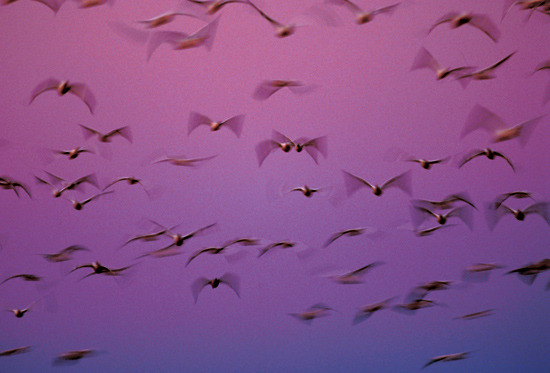2003 BEAUTIFUL BIRDS CALENDARS
BOSQUE IPTs &
THANKSGIVING
I am flying to Bosque this Saturday for the
eighth straight year since Elaine's death on November 20, 1994.
Each trip is somewhat of a pilgrimage to her memory and the
wonderful years that we had together. The three IPTs have filled
nicely, though for the first time in years they have not sold
out. There are three openings on the NOV 18-20 IPT (hurry!), five
spots left on the middle one--NOV 24-26, and room for just two
photographers on the NOV 30-DEC 2 IPT. Having 26 folks join me in
New Mexico for fun, instruction, and simply wondrous photography
in spite of the poor economy is most gratifying.

IMAGE COPYRIGHT 2002
ARHTUR MORRIS/BIRDS AS ART
SNOW GEESE IN
PINK/PURPLE SKY
When the sunrise in
the east looks like a dud, position yourself so that the birds are
in front of the southern or western sky where the light often
ranges from pink to purple on dead-clear mornings. This works
great for flocks either on the water or in flight...
As
many of you know, I have, for the past several years, hosted a
Thanksgiving Day Buffet lunch at the historic Val Verde Steakhouse
in Socorro for photographers and friends. The food is incredibly
good, with tons of turkey and stuffing and yams and all the
fixings as well as table-fuls of great desserts. This year we
will meet at 12:30 pm. All are invited. Bring 70mm dupes or
small prints to show off. I hope that you can join us.
TIM GREY'S DDQ Tim
Grey, who works for George Lepp, publishes an almost-daily
question and answer e-mail service called
Digital
Darkroom Questions (DDQ), which provides
a forum for photographers to have their questions related to the
digital darkroom answered, and to learn from questions asked by
other readers. For more information, or to add your e-mail address
to the list, visit
www.timgrey.com/ddq/." Simply put, Tim's range of knowledge
is incredible..
Here is a Q&A that I found
extremely helpful.
Q: I would be most grateful
if you would explain the rationale for choosing specific settings
for radius and threshold in unsharp mask.
The Unsharp
Mask filter produces a visual sharpening effect by increasing
contrast along edges in your image. Edges are determined based on
where contrast already exists, and that contrast is enhanced with
Unsharp Mask to increase the apparent sharpness. It is important
to understand that your image isn't actually getting sharper. You
can't take an out of focus image and make it look sharp. The
Unsharp Mask filter is rather a tool for optimizing the apparent
sharpness of an image, and to compensate for the loss of sharpness
that is a natural result of digital capture and particularly film
scanning.
The radius
setting determines how far out from each pixel the filter will
look for contrast. A very high setting means the filter will look
very far, resulting an extreme halo effects in your image that are
generally very undesirable. Therefore, the radius setting is the
most important one in terms of image quality, and generally should
be kept relatively low. I generally recommend a value of 1.0 to
1.5 for images that will be output around 300 dpi. However, the
optimal setting will vary from image to image based on specific
content, so you'll want to fine-tune it accordingly.
The
threshold setting determines how much contrast must exist between
two pixels for them to be considered an edge. The higher the
setting, the more difference must exist before additional contrast
is introduced in a particular area. The threshold setting can
therefore be used to mitigate excessive sharpening. It is
particularly useful in helping to eliminate noise and to avoid
over-sharpening images that have areas you don't want to
over-emphasize. Portraits are a perfect example. You want a nice
sharp image, but you don't want to over-emphasize each pore on the
model's face. Increasing the threshold will provide the solution.
The question
then becomes how to determine the best settings based on this
rationale. Generally speaking I do recommend some very basic
parameters that help simplify the process for photographers. You
can set the radius to 1.0 or 1.5, and pretty much leave it there.
You can then put the threshold at 4 for most images, increasing it
to 8 or so for portraits. Then you simply adjust the amount to
suit the image, generally setting it somewhere between 75 and 125.
If you want
to be a bit more detailed, you can set the amount to about 100 and
threshold to 0, then adjust the radius to determine the best value
based on when haloes start to appear in the image. Once that
setting is in place, fine-tune the amount to perfect the
sharpening, and finally increase the threshold as needed to help
eliminate noise and avoid over-sharpening.
Many favor
the use of a very high amount and very low radius setting for
digital captures. Because images captured digitally don't have
grain and are generally more sharp to begin with, this is a good
strategy. The net result is to increase contrast more
significantly at edges, but not "look" as far from each pixel to
find those edges. Typical values in this scenario might be 0.4 to
0.6 for radius and 300 to 500 for amount. .
2003 BEAUTIFUL BIRDS CALENDARS
Still cannot get to the washing machine.
Please order your calendar(s) today. They make great gifts!
Click here for details:
http://www.birdsasart.com/#BIRDS